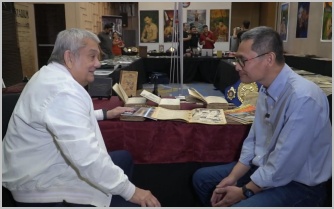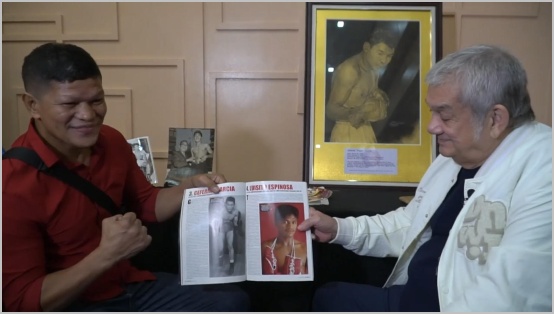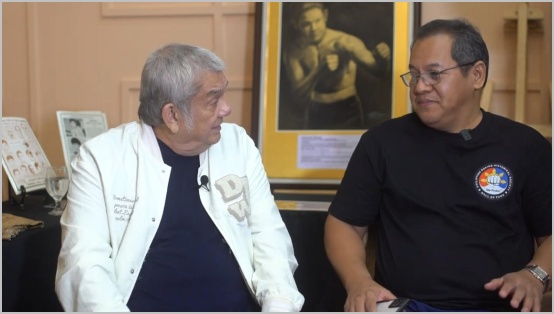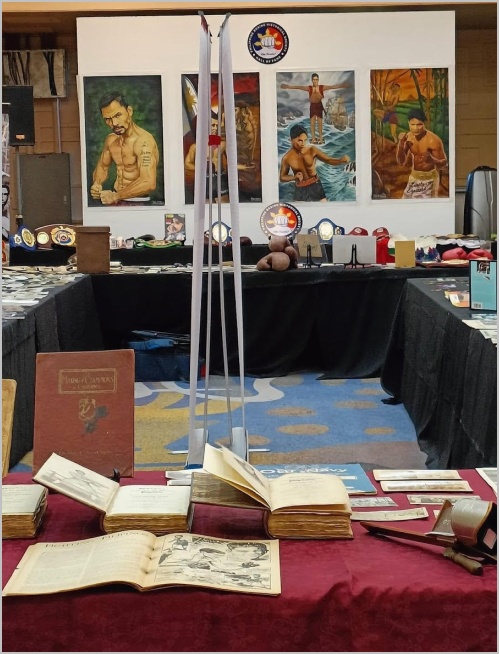
|
Philippines, 25 Dec 2025 |
Home >> News |
 |
||||
|
|
|
|
A Seat at the Table of Antonio Lopez Aldeguer: A Reminiscence By Emmanuel Rivera, RRT PhilBoxing.com Fri, 25 Apr 2025  On March 22, 2024—on the eve of the Gala of Champions—I met Antonio Lopez Aldeguer in person for the first time. We sat quietly in the Ambassador Suite at the Manila Grand Opera Hotel. The celebration was still a day away, but already it felt sacred. Not an interview. Not even a formal meeting. Just a conversation in the key of reverence—spoken to a man whose name carries weight, and to someone unseen. My father. I believe he was there that afternoon, just outside the frame. Watching. Nodding. Proud. Sir ALA isn’t one for cameras. But that day, with Ronald Sardes and Rommel Lope behind the lens, and the late Chino Trinidad editing with a gentle hand, something else emerged. Not an interview. A communion. A quiet inheritance. He spoke of Bacolod, of sparring with newsboys for five centavos a round. Of learning from his father, a former amateur boxer. Of being inspired by his uncle—the original Tony Aldeguer—once the Oriental Welterweight Champion. No bravado. Just gratitude. From grassroots gyms in Visayas and Mindanao to co-promotions with Golden Boy, Sir ALA lifted Filipino boxing from its knees. Donnie Nietes. Milan Melindo. AJ Banal. So many. And still, he deflected praise. “Luisito Espinosa,” he said. “That’s the man you should be honoring.” 
And right on cue, Luisito walked in. They embraced—two champions of very different kinds. One in the ring. One behind the scenes. 
Then Jun Aquino arrived, carrying a full-blown painting of Gabriel “Flash” Elorde—vivid and reverent. Sir ALA marveled at Jun’s talent, especially upon learning he had been painting since the age of six. And as I watched them side by side—the artist and the promoter—I thought to myself: “Jun built with brushstrokes. But Sir ALA—he built with belief.” He spoke of Flash again—how he first followed him as a high school sports reporter. “He was more than a fighter,” he said. “Everyone liked him, even his opponents. He was a gentleman.” He remembered Lope “Papa” Sarreal, too. “When Flash retired, both he and Papa stayed at my house. Not as guests, but as family.” Then I handed him an old image of the Flash. He paused, eyes narrowing with recognition. “I used to keep one just like this on the headboard in my bedroom when I was a young man,” he said. And then, a quiet moment. A charge passed down: “Gone are the breed of the likes of Hermie Rivera and of Recah Trinidad. Now, Chino… and you. You must carry this forward.” When our talk wound down, he asked where the Olympic Stadium once stood. We stepped outside the hotel and looked across the street. I pointed past the intersection of Calle Doroteo Jose and Avenida Rizal. “This was our Madison Square Garden,” I said. “Pancho Villa. Dencio Cabanela. Ceferino Garcia. This was their throne.” The stadium was long gone—claimed by war, calamity, and time. A high-rise stood there now. But between shadows, memory lingered. Sir ALA stood silently, hands behind his back. 
Back inside the Ambassador Suite—transformed that day into an intimate gallery—we hosted a quiet exhibit: a day of reminiscence through mementos. Sol Levinson’s weathered gloves. The Thrilla in Manila tribute wall. 
And at its heart: The Ring Magazine, January 1923—Pancho Villa on the cover. The first Filipino world champion, eyes full of a nation’s hope. Sir ALA stood in stillness. Then he whispered, almost to himself: “What you have here are not just artifacts. These are memories that cannot be bought.” He spoke not of championships or acclaim, but of the people who mattered most. Of his wife, Lou—his partner for over 55 years. Of the family they had raised with quiet strength. “I’m proud of my sons,” he said, the words settling like truth. “And now, our grandchildren… they’re growing into their own. If I’ve built anything lasting, it’s them. That’s the kind of legacy I hope to leave behind.” 
That weekend, as he received the very first Lifetime Achievement Award from the Philippine Boxing Historical Society and Hall of Fame, his family stood beside him. His wife, with quiet strength. His grandson and two granddaughters, full of pride. It was a moment of recognition not only for a career in boxing—but for a life lived with dignity, generosity, and grace. A family moment, framed by history. As the evening closed, I glanced at the chair where he had sat. I understood then—this wasn’t just a meeting. It was an invitation. A tradition not just to honor, but to carry forward. “You’ve done something special,” he said before leaving. “Something Herculean.” Then he added, almost as a promise: “When the time is ripe again—Cebu, 2026.” So call him a promoter. A mentor. A man of vision. But to me—and to my father—Sir ALA will always be something more. He is the man in our corner. Though the video remains quietly in the archives, these still photographs are shared not for posterity, but as a gesture of quiet gratitude—for the rare and humbling honor of having shared the frame, however briefly, with one of my childhood heroes. And I look forward to once again having a seat at his table. Click here to view a list of other articles written by Emmanuel Rivera, RRT. |
|
|
PhilBoxing.com has been created to support every aspiring Filipino boxer and the Philippine boxing scene in general. Please send comments to feedback@philboxing.com |
PRIVATE POLICY | LEGAL DISCLAIMER
developed and maintained by dong secuya © 2025 philboxing.com. |